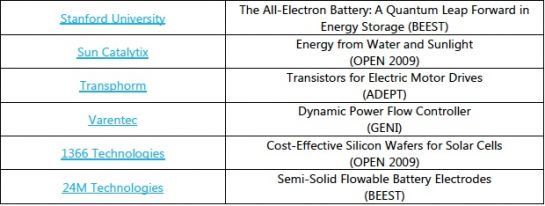ARPA-E, the Department of Energy’s cutting-edge energy research program, is seeing increased private-sector buy-in for the projects it’s brought from concept to near-commercialization reality. But with those successes come some failures, and not a few pivots to realign original plans to meet the needs of the market.
This is the update from this week’s ARPA-E Energy Innovation Summit outside Washington, D.C., where the program meant to recreate DARPA’s technological achievements, such as the development of the internet, in the energy sector is taking its annual appraisal of how far it’s come in its five years of existence, and where it’s planning to go next.
On Tuesday, ARPA-E announced that twenty-two projects that have received about $95 million in federal funding have raised a collective $625 million in private-sector investment. That figure is up from last year’s tally of seventeen projects with $70 million in ARPA-E funding gathering $450 million in private sector funding.
This figure doesn’t include the two ARPA-E funded companies that have gone public in the past few years. One, bioengineering company Ceres, raised $65 million in its February 2012 IPO, far less than the $100 million it had targeted, and has since seen shares fall from a high of more than $17 a share to less than $2 per share today. The other, Ideal Power, raised $17.5 million in its December IPO, and is starting to bring its unique power converter technology to market (stay tuned for more on Ideal Power coming soon).
That’s out of 362 projects that have received more than $900 million through ARPA-E’s programs and open solicitations, and that list keeps growing. Just this month, Energy Secretary Ernest Moniz announced $30 million for twelve projects seeking to combine solar PV and solar thermal energy storage, under its FOCUS (Full-Spectrum Optimized Conversion and Utilization of Sunlight) program. Another $30 million program, titled REBELS (for Reliable Electricity Based on Electrochemical Systems), launched in November to solicit projects that can combine chemical energy storage systems such as fuel cells with solar, and awards for that project are expected to be announced soon.
At the same time, eighteen projects funded by ARPA-E have been canceled prior to their completion, Cheryl Martin, interim director of the agency, said in a Tuesday talk with reporters. That’s not unexpected, perhaps, given the experimental nature of the projects being funded in fields from power electronics and renewable energy to biofuels and carbon capture and sequestration.
More common than failures, Martin said, are projects that have “pivoted, either in their technical approach, or where they were going with it, how they engaged with the market.” That can apply to applying technologies to end uses different than those originally envisioned, as well as to finding ways beyond standalone commercialization to bring these technologies to market.
Corporate strategic investors and licensing partners are one likely route, particularly for technologies like materials science or carbon capture that require huge infrastructure investments to bring to scale, Martin said in a Monday interview.
Another common partner is the government: witness ARPA-E grant-winning flow battery company Primus Power and its work with defense contractor Raytheon on a microgrid project at the Marine Corps Air Station in Miramar, Calif. More than sixteen ARPA-E projects have partnered with other government agencies for further development.
Other ARPA-E programs, such as its SWITCHES (Strategies for Wide-Bandgap, Inexpensive Transistors for Controlling High-Efficiency Systems) funding for next-generation semiconductors, are broad enough to potentially apply from everything to microelectronics to electric vehicles, variable-speed drive motors, solar inverters and grid-scale power electronics, she noted.
“We don’t know today what value people will start to attribute to it, once they see it’s possible,” Martin said. She highlighted the importance of “staying close to [the] market," so that the "market feeds you back the information on where these things are going to be used.”
And while venture investment is one way to measure success in the green technology field, it’s far from the only one, she said. Some ARPA-E grant-winning companies have done well raising VC funding and landing customers and partners on their own, such as smart grid data analytics startup AutoGrid, she noted. But others have business models that simply don’t mesh with the fast and outsized returns that VC investors are looking for.
“If we were a venture firm, we’d be saying, when are they going to go public? When do we get an outcome? At ARPA-E, I don’t care if they go public,” she said. “What I want them to do is to get that technology into the market.”
Here’s the complete list of ARPA-E projects that have won private funding to date:





